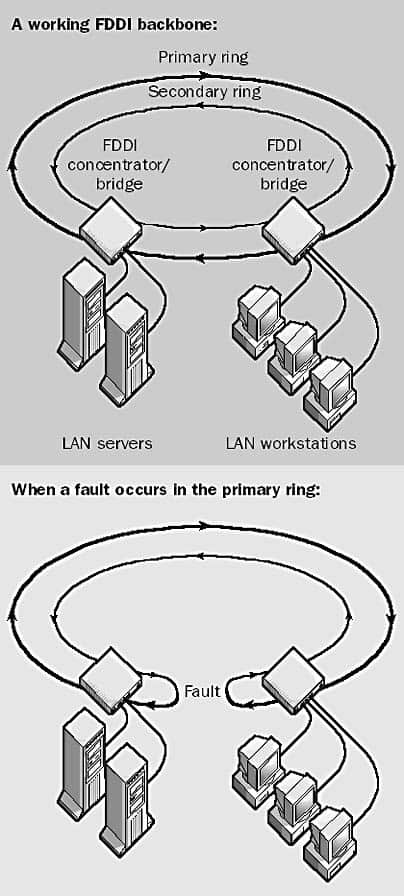Fiber Distributed Data Interface, or FDDI, is a high-speed network technology which runs at 100 Mbps over fiber-optic cabling, often used for network backbones in a local area network (LAN) or metropolitan area network (MAN).
What is Fiber Distributed Data Interface (FDDI)?
A high-speed network technology, conforming to the Open Systems Interconnection (OSI) reference model for networking and the American National Standards Institute (ANSI) standard X3T9, which runs at 100 Mbps over fiber-optic cabling; often used for network backbones in a local area network (LAN) or metropolitan area network (MAN).
How FDDI Works?
Fiber Distributed Data Interface (FDDI) is usually implemented as a dual token-passing ring within a ring topology (for campus networks) or star topology (within a building). The dual ring consists of a primary and secondary ring. The primary ring carries data. The counter-rotating secondary ring can carry data in the opposite direction, but is more commonly reserved as a backup in case the primary ring goes down. This provides FDDI with the degree of fault tolerance necessary for network backbones. In the event of a failure on the primary ring, FDDI automatically reconfigures itself to use the secondary ring as shown in the illustration. Faults can be located and repaired using a fault isolation technique called beaconing. However, the secondary ring can also be configured for carrying data, extending the maximum potential bandwidth to 200 Mbps.
Stations connect to one (or both) rings using a media interface connector (MIC). Its two fiber ports can be either male or female, depending on the implementation. There are two different FDDI implementations, depending on whether stations are attached to one or both rings:
- Single-attached stations (Class B stations): Connect to either the primary or secondary ring using M ports. Single-attached FDDI uses only the primary ring and is not as commonly deployed for network backbones as dual-attached FDDI. Single-attached stations are used primarily to connect Ethernet LANs or individual servers to FDDI backbones.
- Dual-attached stations (Class A stations): Connect to both rings. The A port is the point at which the primary ring enters and the secondary ring leaves; the B port is the reverse. M ports provide attachment points for single-attached stations. Dual-attached FDDI uses both rings, with the secondary ring serving as a backup for the primary. Dual-attached FDDI is used primarily for network backbones that require fault tolerance. Single-attached stations can be connected to dual-attached FDDI backbones using a dual-attached device called a concentrator or multiplexer.

FDDI uses a timed token-passing technology similar to that of token ring networks as defined in the IEEE 802.5 standard. FDDI stations generate a token that controls the sequence in which other stations will gain access to the wire. The token passes around the ring, moving from one node to the next. When a station wants to transmit information, it captures the token, transmits as many frames of information as it wants (within the specified access period), and then releases the token. This feature of transmitting multiple data frames per token capture is known as a capacity allocation scheme, in contrast to the priority mechanism used in the IEEE 802.5 token ring standard. Every node on the ring checks the frames. The recipient station then reads the information from the frames, and when the frames return to the originating station, they are stripped from the ring.
There can be up to 500 stations on a dual-ring FDDI network. The maximum circumference for an FDDI ring is 100 kilometers (or 200 kilometers for both rings combined), and there must be a repeater every 2 kilometers or less. Bridges or routers are used to connect the FDDI backbone network to Ethernet or token ring departmental LANs. For these reasons, FDDI is not often used as a wide area network (WAN) solution, but is more often implemented in campus-wide networks as a network backbone.
NOTE
FDDI frames encapsulate LAN traffic for transmission of LAN packets over FDDI backbones. The maximum frame size for an FDDI frame is 4500 bytes. FDDI implementations use one of three possible framing formats:
- FDDI-raw: Supported by Cisco routers running Internetwork Operating System (IOS) versions 11.1 .x and later, and by some third-party vendors
- FDDI with LLC: Supported by IOS versions 10.0 and earlier
- FDDI with LLC and SNAP: Default format for encapsulating Internetwork Packet Exchange (IPX) packets on FDDI
FDDI implemented over copper cabling instead of fiber-optic cabling is called Copper Distributed Data Interface (CDDI).
TIP
FDDI makes a great network backbone for an Ethernet or Token Ring network. Put your servers directly on the FDDI ring to increase server performance. When bridging between Ethernet LANs and FDDI backbones, be aware that there are two different types of bridges:
- Encapsulating bridges:Encapsulate Ethernet frames into FDDI frames
- Translating bridges:Translate source and distention MAC addresses into FDDI addresses
These two FDDI bridging technologies can cause incompatibilities. For example, while Cisco FDDI bridges can generally interoperate with translating bridges from other vendors, their encapsulation method is proprietary and usually won’t work with encapsulating bridges from other vendors. Both types of bridging methods are commonly used in FDDI networks.
The following table shows some troubleshooting tips for FDDI networks.FDDI Troubleshooting
| Problem | Suggestions |
| FDDI ring is not functioning. | Check the status of the router’s FDDI interface, making sure the interface and line protocol are up. Try pinging a remote router. Check the physical connections of the cable; use an optical time domain reflectometer to test for problems. |
| Signal is degraded. | Check whether the upstream FDDI neighbor has failed and the bypass switch has been activated. |
Explaining FDDI meaning and how it works
FDDI was effectively made obsolete in local networks by Fast Ethernet which offered the same 100 Mbit/s speeds, but at a much lower cost and, since 1998, by Gigabit Ethernet due to its speed, and even lower cost, and ubiquity.